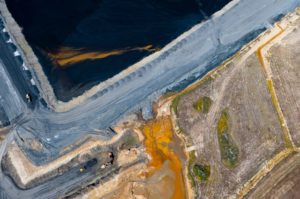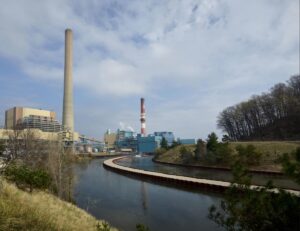Dan E Karn coal plant, Michigan
September 03, 2025
Coal Plants in the Midwest: What Happens After They Close?
Dataset details the status of coal plants across the Midwest, which could be transformed into community assets that provide economic benefits to surrounding communities
by Olivia Schenker, Policy Intern 2025
Last winter, I had the wonderful opportunity to serve as a Policy Intern at the Environmental Law & Policy Center (ELPC) in Chicago. During my time at ELPC, I mainly supported the Power Plants to Parklands (P2P) initiative, which aims to redevelop retired coal plant sites into public parks, beaches, greenways, and natural areas and repurpose the existing grid connection for solar energy and storage.

Coal ash deposits by a coal plant
Over the past decade, high fuel and maintenance costs, coupled with climate and clean-energy policies, have driven many U.S. coal plants to close or convert to different energy sources, mostly natural gas. This is a positive trend. Coal plants are not only costly to operate, but are increasingly unreliable, and pose serious health and environmental risks from their greenhouse gas emissions, other toxic air pollution, and coal ash waste.
Some of the retired coal plant sites, however, now face a murky future and sit indefinitely as fenced-off brownfields. These properties involve hundreds, even thousands, of acres at prime locations along rivers and lakes, including the Great Lakes shoreline. The P2P initiative seizes this once-in-a-generation opportunity by transforming these sites into waterfront parks, greenway trails, and protected natural areas and repurposing the existing grid connection to install solar power and battery energy storage. Local communities, in turn, gain green space, outdoor recreational opportunities, tax revenues, and clean-energy jobs.
P2P projects advance in Michigan, eye Midwest expansion
P2P projects are coming to fruition in Michigan, where ELPC’s P2P team is actively working with partners to plan the future of three sites: Consumers Energy’s retired Dan E. Karn coal plant on Lake Huron and retiring J.H. Campbell plant on Lake Michigan, and DTE’s demolished Trenton Channel plant on the Detroit River just north of Lake Erie.
To support the potential expansion of the P2P project to more retired coal plant sites in the Midwest, ELPC needed a more comprehensive understanding of coal plant activity in the region. To assist with this goal, I developed a dataset detailing the status of coal plants across the Midwest, including their plans for retirement, conversion to renewables, and/or their continued reliance on coal. This dataset also accounts for community concerns, surrounding demographics, and stakeholders near Midwest coal plants, which aids in informing our search for future P2P project sites. In addition, this dataset provides information about the current landscape and trends of coal plants in the Midwest and was used to create a map to make these findings more accessible.
How is the coal landscape in the Midwest changing?
While coal-fired generating facilities are spread across the United States, the Midwest accounts for the largest coal-based capacity of any U.S. region, at nearly 50 gigawatts (GW), as well as the most capacity set to be retired (10 GW) by the end of 2028.
Of the 160 electrical-generating coal plants surveyed in the Midwest, 48 plants, or about 30% have fully retired since 2016, meaning these sites have been shut down and not converted to another form of energy. Most of these closures have occurred in Ohio (17 plants), Michigan (14), and Illinois (12) (Figure 1).

Figure 1. Recently retired coal plants in the Midwest (most states begin from 2016) with retired plants marked in brown. Click to see interactive map
Meanwhile, 33 Midwest generating plants continue to operate entirely on coal, with no announced plans for retirement or transition to an alternative or supplemental energy source (Figure 2). Minnesota has the most of these instances, with six plants still relying exclusively on coal.

Figure 2. Operating coal plants in the Midwest that are producing energy only from coal with operating plants marked in blue. These plants have no plans for retirement or conversion to another energy source and have not retired any of their generating units. Click to open interactive map.
The largest share of coal plants in the Midwest, 68 facilities to be exact, are transitioning away from coal (Figure 3). These include facilities that utilize or plan to utilize an alternative energy source or have retired or plan to retire some of their generating units. Notably, Wisconsin and Iowa have the most coal plants operating with generator conversions to different energy sources, each having six. Most of these plants, and other sites with partial conversions – conversion of some but not all of a plant’s coal units – now rely on natural gas as a fuel source.

Figure 3. The status of coal plants across the Midwest. Plants are color coded based on their status: operating, operating with conversions, operating with partial and planned conversions, operating with partial and planned retirements, operating with partial and planned retirements and partial conversions, operating with partial conversions, operating with partial retirements, operating with partial retirements and construction, operating with partial retirements and partial conversions, operating with partial retirements and planned conversions, operating with planned retirements, operating with planned retirements and planned conversions, operating with retirements and conversions, and operating with planned and partial retirements. Click to see interactive map.
The shift from coal to natural gas and renewables
According to a 2020 EIA report, coal-to-gas conversions have become more common due to the lower cost of natural gas, stricter environmental regulations, and more efficient technology. While burning natural gas or methane for energy emits fewer greenhouse gases than burning coal does, it is still a fossil fuel. Methane in the atmosphere is over 84 times more potent than carbon dioxide over a 20-year time horizon, but it does not linger as long as carbon dioxide: just 10-12 years versus hundreds or even thousands of years.

Consumers Energy’s J.H. Campbell coal plant, Ottawa County, MI
While coal plant conversion to natural gas is a step in the right direction, it is not a long-term or sustainable solution. It is important that the United States moves away from fossil fuels entirely if we are to reduce our greenhouse gas emissions. Retired coal plants offer a powerful opportunity to accelerate this transition through conversion to clean, renewable solar energy and storage. Electricity is electricity, and the wires that once connected coal plants to the grid can just as easily carry energy from solar panels and grid-scale batteries from the same site. In line with the mission of ELPC’s P2P initiative, these sites should also be transformed into community assets that provide recreational, environmental, and economic benefits to surrounding communities, developed in partnership with those who live closest to them. Through these redevelopment projects, we can create spaces that benefit everyone, the economy, and the environment.
However, the future of coal-fired generation has recently become increasingly uncertain. In some cases, stations are being required to extend or resume their coal power generating operations. For example, although on track to retire in 2025, the J.H. Campbell generating plant in West Michigan was ordered by the Department of Energy in May and again in August to continue producing coal-generated electricity for a 90-day period, citing the potential for energy shortfall, which ELPC and allies are contesting. This reversal is expected to have significant negative health and economic consequences for communities in the Midwest. The first three months alone cost ratepayers more than $50 million. Despite these setbacks, P2P’s vision for the future remains unwavering. P2P will continue to pursue opportunities to transform coal plant sites into clean energy facilities that are powered by affordable, reliable, and renewable sources.

